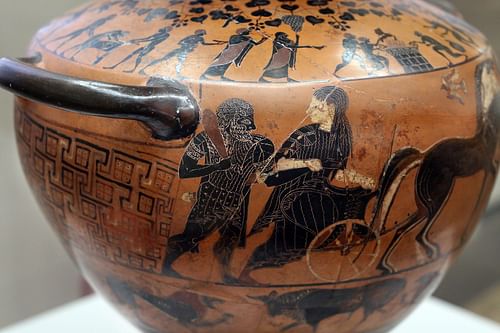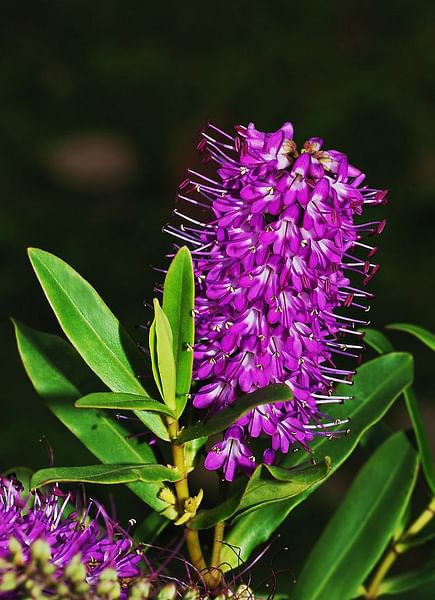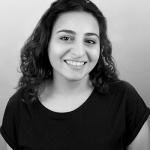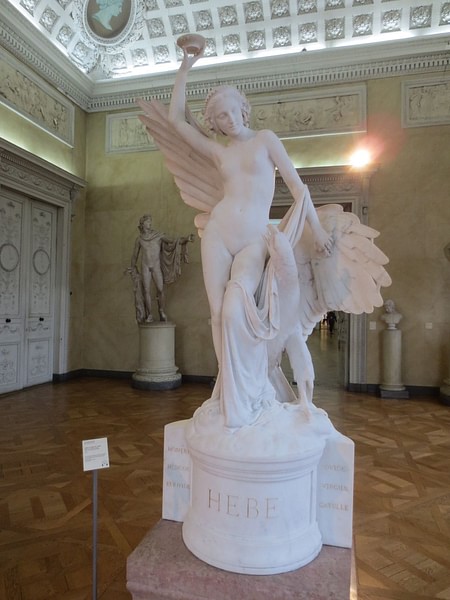
Hebe (meaning "youth" or "bloom of youth") is the goddess and personification of eternal youth in Greek mythology. She is the daughter of Zeus and Hera and the wife of the Greek hero Hercules. Hebe serves as the cupbearer for the gods and goddesses of Mount Olympus, and she has the gift of restoring youth to mortals.
In art, Hebe is depicted as a young virgin, holding a cup and wearing a flower crown or a golden wreath and a garment made up of varying colours. She often has dark hair and sparkling eyes and is sometimes accompanied by an eagle (symbolising Zeus). Pindar (c. 518 to c. 448/7 BCE), the ancient Greek lyric poet, referred to Hebe as the "fairest of all the goddesses" in his Nemean Odes, while in the Odyssey, Homer (c. 750 BCE) states that she was famed for her "alluring ankles." Hebe's Roman counterpart is Juventas.
Birth & Family
In Hesiod's (c. 700 BCE) Theogony, Hebe is listed as the daughter of Zeus and his sister-wife Hera, and the sister of Ares, the god of war, and Eleithyia, the goddess of childbirth. She was also a half-sister to the Graces, the Fates, and the Horae.
Last he took blooming Hera for his wife;
Uniting with the king of gods and men,
She gave him Hebe and Ares, and she bore
The goddess Eileithuia to her mate.(Theogony, 921-925)
After Hebe's birth, the gods fought amongst themselves to give her gifts and honour. Athena and Poseidon gave her toys, while Apollo soothed her with his music. A rarer story of Hebe's birth has Hera becoming pregnant after eating or touching lettuce at a banquet with Apollo.
Cupbearer to the Gods
Although Hebe was the daughter of the king and queen of the gods, she was given the role of cupbearer to the immortals. Her role is in line with ancient patriarchal customs, where the females in the home assisted with serving guests. She served the deities of Mount Olympus with wine, nectar and ambrosia in golden goblets. In the Iliad, Homer mentions that Hebe served wine to the gods as they watched the battle between Menelaus and Paris.
Now aloft by the side of Zeus the gods sat in council,
conferring across Olympus' golden floor as noble Hebe
poured them rounds of nectar. They lifted golden beakers,
pledging each other warmly, gazing down on Troy…(Iliad, 4.1-4)
Hebe's time as cupbearer to the gods came to an end after she experienced a moment of ungracefulness and slipped while serving the gods. Zeus immediately dismissed her from her role and replaced her with the Trojan youth Ganymede, considered the most beautiful mortal by Zeus. Naturally, Hera was angered by her daughter's dismissal and her husband's affection for Ganymede. Annoyed by her anger, Zeus only continued to show his love for the youth by setting Ganymede's image among the stars as Aquarius, the water-bearer.

Other sources state that Hebe stopped being the cupbearer to the gods when she married Hercules. Early on, Hebe was known as Ganymeda, which suggests that this deity was split into two – the male Ganymede, who carried on the job of cupbearer to the gods, while Hebe became a wife to Hercules and a mother to their two sons.
Handmaiden to Hera
As the daughter of Hera, Hebe also served as her handmaiden, preparing her chariot and harnessing her peacocks whenever they were needed. In Book 5 of the Iliad, Hebe helped her mother prepare her chariot by rolling the wheels, fastening them to their bronze spokes and bolting them on the ends of the iron axle. In various sources and depictions in Greek art, she is found standing beside her mother, ready to obey her orders.
Hebe also washed Ares and dressed him in clean robes after he had engaged in a fierce battle against King Diomedes of Argos during the Trojan War. Hebe and Ares then returned to Mount Olympus.
Goddess of Youth
As the goddess of youth, Hebe had the power to restore youth to mortals. The ancient Greeks viewed her as being brave and generous. Philostratus of Lemnos (190-230 CE) writes that Hebe was the youngest of the gods and the most loved. According to him, Hebe is the reason why the Olympian gods are eternally young. Hebe's power is touched on in a few myths, which are retold in Ovid's (43 BCE to 17 CE) Metamorphoses.
The Greek hero Jason pleaded with his sorceress wife, Medea, to take years off his life and give them to his ailing, elderly father, Aeson, so that he may live longer. Medea refused to do this, not able to face taking years off her husband's life. Instead, she told Jason that she would ask Hecate for help. Medea and her dragons roamed the Earth for nine days, collecting herbs of renewal. She built two altars of green turf, one dedicated to Hecate and the other dedicated to Hebe. She invoked the sorceress and goddess of youth for help. Sure enough, with their help, Medea was able to restore Aeson's youth.
Hercules asked his wife to bestow the gift of youth to his dear friend and nephew, Iolaus, so he could take revenge on King Eurystheus for the hardship he had put Hercules, Iolaus and their families through. Hebe agreed and gave Iolaus his youth back, but then swore that she would never use her gift on anyone else. However, Themis, the goddess of justice and divine law, stopped her from making that promise and reminded her of the Theban civil war taking place.
Themis prophecised that Callirhoe, daughter of the river god Achelous, would beg for Zeus to add the years that Iolaus had lost to her own young sons so that they could avenge their father. Hebe's gift would therefore be granted through Zeus' intervention. The gods were not happy that others would be given the gift of youth, and each one put forward someone they had in mind to receive Hebe's gift.
Hebe & Hercules
After Hercules is accidentally sent a poisoned shirt by his wife, Deianira, he puts it on, unaware that it had been covered with Hydra's venom. As he was praying to the gods and pouring libations, the heat from the fire caused the poison to spread through his body quickly. After killing his servant Lichas who had delivered the shirt into his hands, he built himself a funeral pyre and laid down on it.
The gods watched in horror from Mount Olympus as Hercules burned. Zeus reassured them that as his son, Hercules could not be touched by death and that he would be welcomed to Mount Olympus and given immortality.

After Hercules' apotheosis (deification) was complete, Zeus and Hera allowed him to marry Hebe, cementing his new position as a god and forever uniting him with immortal youth. Hercules and Hebe's marriage was a sign that Hera had finally gotten over her hatred of Hercules (as he was a reminder of Zeus' infidelity), or at least was not so spiteful towards him as she was before. Hercules and Hebe had two sons together: Alexiares and Anicetus.
And then strong Heracles, the glorious son
Of trim-ankled Alcmene, at the end
Of all his painful labours, made his bride
Hebe, the modest child of mighty Zeus
And golden-slippered Hera, on snow-clad
Olympus. Happy god! For he has done
His great work and he lives among the gods
Forever young, forever free from pain.(Hesiod, Theogony, 950-957)
Worship & Legacy
The two main areas of worship for Hebe in Greece were Philos and Sicyon, located in the Peloponnese. According to Strabo (63 BCE to 23 CE), the Greek geographer, they worshipped Hebe as Dia. People prayed to Hebe for forgiveness, and released prisoners left behind their prison chains on trees in sacred groves to pay honour to her. In Philos, the head of Hebe and wreaths of ivy appeared on coins.
According to Pausanias (c. 115 to c. 180 CE) in his Description of Greece, in Corinth, Hebe had a sanctuary and a golden and ivory statue made by the Greek sculptor Naukydes of Argos (4th century BCE) that stood beside a statue of Hera, with a peacock (Hera's sacred animal) between the figures. There was also a silver altar that was decorated with the wedding of Hercules and Hebe. Hebe and Hercules had adjoining sanctuaries, which were separated by running water. Hens were kept in Hebe's sanctuary, while cocks were kept in Hercules'. In the Cynosarges (a cult centre for Hercules), there were altars dedicated to both Hercules and Hebe.

The flower species Hebe is named after the goddess of youth. Over 70 types of shrubs are found throughout the Southern Pacific, especially in New Zealand and South America. The flowers come in a variety of colours, including red, pink, white, purple, and blue, making them a popular plant to brighten up gardens.
Hebe is also the name given to a large asteroid that orbits between Jupiter and Mars in the central asteroid belt. Hebe is not classified as a dangerous asteroid, as its orbit does not bring it close to the Earth.








